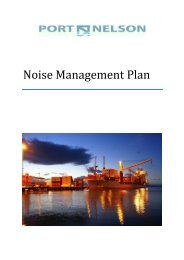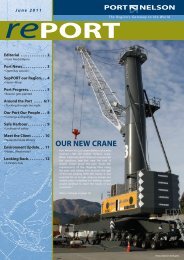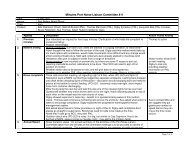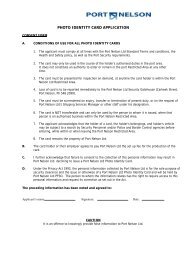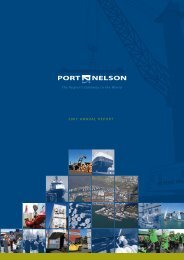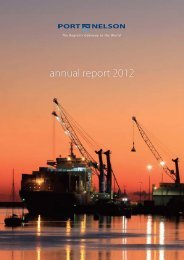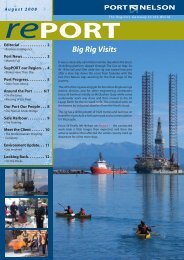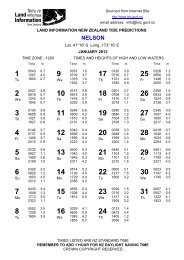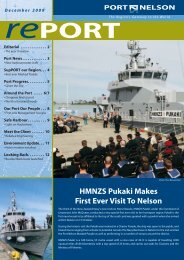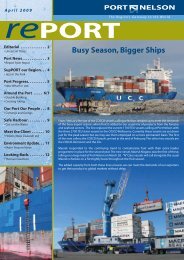You also want an ePaper? Increase the reach of your titles
YUMPU automatically turns print PDFs into web optimized ePapers that Google loves.
<strong>August</strong> <strong>2010</strong><br />
rePORT<br />
International........... 2<br />
• Parke goes global<br />
<strong>Port</strong> News.............. 3<br />
• Long tow<br />
SupPORT our Region. .. 4<br />
<strong>Port</strong> Progress. ......... 5<br />
• Wind monitors<br />
Around the <strong>Port</strong> .. . . . . 6/7<br />
• The apples are off<br />
• Loaded with Logs<br />
Our <strong>Port</strong> Our People.. . . 8<br />
• On the big screen<br />
Safe Harbour........... 9<br />
• Safe Water<br />
Meet the Client.. . . . . . . 10<br />
• <strong>Nelson</strong> Forests<br />
Environment Update. ..11<br />
• Could it happen here?<br />
Looking Back. . . . . . . . . 12<br />
• <strong>Port</strong> <strong>Nelson</strong> Haven Ahoy!<br />
Photo: Troy Dando<br />
t<br />
Twenty - Four Seven<br />
The work of the port goes on night and day, winter and summer. The tail end of the fruit season ensures<br />
the wharves are busy right through to the shortest day, and there is plenty of other cargo to keep up the<br />
momentum year round. <strong>Port</strong> workers wrap up to keep warm as they turn out for winter night shifts that<br />
keep the region’s exports moving and maintain the port’s lifeblood in a rhythm that is truly 24-7.<br />
t<br />
Nature’s surfers<br />
If seals were able to study history they’d realise the life they lead now is a cruisey one, compared with the<br />
early 1800s, when they were hunted almost to extinction, with their fur valued for coats and rugs. Now<br />
that we wear polar-fleece and have developed more empathy for marine mammals, the southern fur seal<br />
has made a comeback around our coastline. Numbers are higher in winter when they sun themselves, in<br />
this case at the Cut, feasting on seafood ready for the coming ‘maternity’ season.
<strong>Port</strong> <strong>Nelson</strong> Limited report. <strong>August</strong> <strong>2010</strong>. Page 2<br />
international<br />
Parke goes global<br />
At TOC Europe in June, the president of the <strong>Port</strong> Authority of Valencia, Rafael Aznar (centre), signed an agreement with representatives of (from left) Nam <strong>Port</strong>s of<br />
Namibia, Tees <strong>Port</strong> of the UK, the National <strong>Port</strong> Authority of Peru and <strong>Port</strong> <strong>Nelson</strong> of New Zealand. With this agreement, these ports joined the <strong>Port</strong> Cluster Governance<br />
Committee to work on the production of the <strong>Port</strong> Cluster Best Practice Guide. Parke Pittar is on the far right.<br />
New Zealand was often said to be ‘punching<br />
above its weight’ when competing in the<br />
America’s Cup, so it was fitting that in the<br />
cup’s Spanish HQ, Valencia, the same thing<br />
was said of the New Zealand port sector.<br />
And it’s largely thanks to our own Chief<br />
Commercial Officer Parke Pittar.<br />
Last year Parke attended the Terminal Operators<br />
Conference (TOC) in Bremen, Germany, and<br />
attended a talk about the corporatisation of<br />
ports. When the speaker used an inaccurate<br />
illustration involving New Zealand ports, Parke<br />
says he ‘politely corrected him’. The CEO of the<br />
Global Institute of Logistics (GIL) was there,<br />
and the upshot was, alongside this year’s TOC<br />
Europe in Valencia, <strong>Port</strong> <strong>Nelson</strong> was invited<br />
to join a port bench-marking think tank, the<br />
<strong>Port</strong> Cluster Governance Committee, and to<br />
contribute to a guide to best port practices.<br />
Whilst Los Angeles is contributing the chapter<br />
on environment, and Hamburg is writing the<br />
section on marketing, Parke will be responsible<br />
for governance, as modelled in New Zealand<br />
since the port reform of 1989, with particular<br />
reference to <strong>Port</strong> <strong>Nelson</strong>.<br />
“The New Zealand port model is not widely<br />
understood, but when it is explained people<br />
“The aim of the<br />
exercise is to share<br />
best practice, to raise<br />
quality levels and<br />
standards and to<br />
provide an exemplar<br />
template for world<br />
ports in general to<br />
use as they wish”.<br />
Parke Pittar presents on the New Zealand<br />
port governance model at the TOC Europe<br />
conference in Valencia.<br />
are very impressed,” Parke says. “New Zealand<br />
is different in that we have successfully<br />
developed a formula where public ownership<br />
is combined with commercial behaviour and<br />
accountability. Many other countries have<br />
port authorities that don’t make money,<br />
and they see the only option as selling up to<br />
private enterprise, often at a price that doesn’t<br />
recognise the potential economic value of<br />
the port.”<br />
Parke says it is a tremendous feather in<br />
the cap for <strong>Port</strong> <strong>Nelson</strong> Ltd to be ranked<br />
alongside heavyweight ports like Singapore<br />
in the <strong>Port</strong> Cluster Best Practice Guide,<br />
and a testament to the ‘exemplary way’<br />
PNL has used the model provided by <strong>Port</strong><br />
Reform. The guide will be prepared over<br />
the next 12 months and will be a ‘living<br />
document’ that will be extremely useful to<br />
developing ports. Each chapter will have<br />
the academic theory on the topic, a case<br />
study and practical information for other<br />
ports to follow.<br />
“<strong>Port</strong> <strong>Nelson</strong> provides a case study of how<br />
a port authority can negotiate a way of<br />
operating commercially, without facing a<br />
fire sale to private ownership,” Parke says.<br />
<strong>Port</strong> <strong>Nelson</strong> Limited • 10 Low Street, <strong>Port</strong> <strong>Nelson</strong> • PO Box 844, <strong>Nelson</strong>, New Zealand<br />
Tel +64 3 548 2099 • Fax +64 3 546 9015 • www.portnelson.co.nz<br />
Re<strong>Port</strong> <strong>Nelson</strong> is a triennial publication produced for <strong>Port</strong> <strong>Nelson</strong> Limited by:<br />
• <strong>Nelson</strong> Media Agency - www.nelsonmedia.co.nz • SeeReed Visual Communication - www.seereed.co.nz<br />
Photography: Thanks to Troy Dando for his photos in this issue.
<strong>Port</strong> <strong>Nelson</strong> Limited report. <strong>August</strong> <strong>2010</strong>. Page 3<br />
Vice Regal Visit<br />
The Governor General of New Zealand, His Excellency, The Hon Sir<br />
Anand Satyanand was in <strong>Nelson</strong> in May with his wife Lady Susan,<br />
meeting people and getting to know the region better with visits<br />
that included Cawthron, Nutrizeal, Waimea College, <strong>Nelson</strong> Pine<br />
Industries, NIWA and <strong>Port</strong> <strong>Nelson</strong> Ltd.<br />
Chief Commercial Officer Parke Pittar says Sir Anand was approachable<br />
and well informed. “We had a good discussion around the cargo<br />
operation, cargo bases and topical issues such as coastal shipping<br />
and whether New Zealand would benefit from having its own<br />
shipping line.”<br />
port news<br />
The anchor handling tug and supply vessel Marsol Pride was in<br />
port, and the Governor General’s port tour focused on oil and gas<br />
initiatives and the Green <strong>Port</strong> - Black Boat concept for industrial boat<br />
building at <strong>Port</strong> <strong>Nelson</strong>.<br />
Tuna Skiff<br />
The purse-seining skiff that will work from the Talley’s tuna<br />
vessel, Captain M J Souza, was finished in one of the PNL cargo<br />
sheds, by local engineering company Aimex. Managing Director<br />
Steve Sullivan says building this style of boat was a first for the<br />
company. ”We had a tight time frame to meet, with the Souza due<br />
to depart to American Samoa at the end of May,” he says. “Talley’s<br />
arranged to use the PNL shed so the skiff could be sandblasted<br />
and painted inside, to meet the tight time frame.”<br />
PNL chairman Nick Patterson and Parke Pittar pause before embarking on a port<br />
tour with Sir Anand Satyanand.<br />
The 11m skiff was constructed at the Aimex workshop in<br />
Vickerman St and was launched by crane at the port. Steve says<br />
23 tonnes of steel went into the boat, which he describes as being<br />
‘like a big overpowered dinghy’. The role of the skiff in the tuna<br />
fishing operation is to tow the net from the mother-ship to form<br />
a loop around the school of fish.<br />
Long tow<br />
Two weeks is a long time to spend on either end of a tow-line. In a trip that ended in <strong>Nelson</strong> on June 29, the tuna purse-seiner Cape Ferrat was<br />
towed from Fiji by the Hong Kong tug PB Cook. Mike Newton of Pegasus Shipping says the vessel will be in <strong>Nelson</strong> for some time, as Diverse<br />
Engineering carries out repairs. Mike says the owner brought the vessel to <strong>Nelson</strong> because of the excellent refit work offered here. A few days<br />
later one of the <strong>Port</strong> <strong>Nelson</strong> cranes was used to lift the 38 tonne engine out of the vessel.
<strong>Port</strong> <strong>Nelson</strong> Limited report. <strong>August</strong> <strong>2010</strong>. Page 4<br />
supPORTing our region<br />
Photo: Rick Bensemann<br />
New Hospital<br />
Needs More Rooms<br />
It’s been such a success story, they already need more rooms at the<br />
new Motueka Friendship Hospital, so Chairman of the Trust, Jack<br />
Inglis is out again seeking community support. Opening a year<br />
ago, the 44-bed facility was built on land owned by the trust, and<br />
Jack says it was early support from <strong>Port</strong> <strong>Nelson</strong> Limited that helped<br />
make it happen.<br />
“I can’t say thank you enough - there is so much we need and<br />
the fundraising just goes on as we move into the next stage of<br />
development,” Jack says.<br />
Recently <strong>Port</strong> <strong>Nelson</strong> gave another $1000 towards the Abel Tasman<br />
Marble Mountain Bike Race, with funds raised through photo sales<br />
from the event going to the Friends of Motueka Hospital Trust.<br />
Big Day<br />
for Heart Kids<br />
A magic duck and a man balancing on a huge plastic ball were<br />
crowd favourites at the Heart Children New Zealand’s Big Day<br />
Out variety show held in <strong>Nelson</strong> in May. Organiser Jason Butler<br />
said thanks to local business sponsors like <strong>Port</strong> <strong>Nelson</strong>, over 350<br />
children and their families were entertained with magic, juggling,<br />
globe walking and hula-hooping. André and Doctor Duck (below)<br />
were a big hit.<br />
Around twelve babies in New Zealand each week are born with<br />
a heart defect, making it the most common birth abnormality in<br />
this country. Heart Children provides support to families, from the<br />
hospital to their homes.<br />
Growing rugby players<br />
As well as investing<br />
in its own future, the<br />
port company is also<br />
investing in the future<br />
development of<br />
young rugby players.<br />
CEO Martin Byrne<br />
recently announced a<br />
sponsorship deal with<br />
the Tasman Rugby<br />
Union’s <strong>Nelson</strong> Rugby<br />
Academy.<br />
Academy manager<br />
Leon MacDonald says<br />
the sponsorship will<br />
make a real difference<br />
to the future of<br />
rugby in the region.<br />
“This support will give<br />
us the resources we<br />
need to work with<br />
the Academy players<br />
who could be the<br />
next Makos, the next<br />
generation of Super 14<br />
players and who knows,<br />
some may even become<br />
All Blacks”.<br />
By close association<br />
It helps pay the rent, but the port company’s financial support means<br />
a lot more than that to the <strong>Port</strong> <strong>Nelson</strong> Fisherman’s Association.<br />
President, Carol Scott says the fishing industry is <strong>Nelson</strong>’s biggest<br />
employer, and the long relationship the association has with <strong>Port</strong><br />
<strong>Nelson</strong> Limited is very important. “The funding from PNL helps<br />
cover our operating costs and means we can continue representing<br />
the interests and needs of owner-operator commercial fishermen<br />
in <strong>Nelson</strong>.”
<strong>Port</strong> <strong>Nelson</strong> Limited report. <strong>August</strong> <strong>2010</strong>. Page 5<br />
To date P&FR have successfully reared several key seafood and aquaculture<br />
species and have released 220,000 young snapper into the Haven. Sharon Ford<br />
and Warren Fantham check out their babies.<br />
Fish Ponds<br />
There’s a new look coming to a little-used part of the port, with Plant<br />
& Food Research (P&FR) taking over the western end of the Akersten<br />
Street reclamation. They were looking for a flat area to grow fish in<br />
ponds, and this piece of land suits their needs well and has the water<br />
quality needed for rearing fish. P&FR science group leader Alistair<br />
Jerrett says the site will be complimentary to their facilities on<br />
Wakefield Quay. “Having ponds to hold and rear fish is a substantial<br />
step forward in allowing us to help our local seafood companies<br />
extract better value from wild fisheries and to support aquaculture.”<br />
<strong>Port</strong> <strong>Nelson</strong> tidied up the Akersten Street site, laid on water, phone and<br />
power supply and did some fence repairs to make the area secure.<br />
High winds in the yard<br />
A stack of containers presents a serious risk when the wind is howling<br />
across the port, particularly when it’s a nor-easterly that has some<br />
equinoctial force behind it. To ensure the safety of staff, contractors<br />
and property, we had to close the Container Yard several times<br />
during the period from March to May, and we are now installing wind<br />
monitors to take any ‘hit or miss’ out of this decision, with the most<br />
recent monitor installed on the light tower near the ro-ro berth.<br />
“We close the yard down when the wind gets to 40 knots,” says<br />
Terminal Operations Supervisor Andy Farmer. “Often it’s just for a<br />
short time… the wind in <strong>Nelson</strong> has a habit of ramping up on the<br />
turn of the tide and then falling off again quite rapidly.”<br />
Andy says it’s not just the risk of boxes blowing down in the wind: “We<br />
also have to work to the safe operating parameters of the hi-stackers<br />
– a big box moving along at height creates an effect like a sail.”<br />
When the Container Yard is closed staff are called in, contractors<br />
are informed and if it is closed for a longer period, customers are<br />
phoned.<br />
<strong>Port</strong> <strong>Nelson</strong> has had wind monitors for the pilots’ use for some time,<br />
and the new monitors around the boundaries of the Container Yard<br />
feed into the same meteorological information software and can be<br />
accessed by computer.<br />
port progress<br />
The last few centimetres of winch cable as a crane lowers its spreader are vital in keeping down the noise of operation. To assist the operators<br />
to make that moment of touch as gentle as possible we have just fitted our two Liebherr Mobile Harbour Cranes with a Height Indication<br />
System (HIS). This meant installing an ultrasonic sensor in the spreader, that sends a signal to the winch as the container gets closer, and slows<br />
down the descent.<br />
“It seems to be pretty effective and has been well received by the operators,” says workshop supervisor Craig Terris. “We still have to rely on the<br />
operators to take care with putting containers down on the wharf or onto a trailer, but we’ve removed one of the potential noise sources.”
<strong>Port</strong> <strong>Nelson</strong> Limited report. <strong>August</strong> <strong>2010</strong>. Page 6<br />
around the port...<br />
The apples are off<br />
The winds of autumn have given way to the calm, clear<br />
days of winter and something similar has happened in<br />
port operations. Getting <strong>Nelson</strong>’s export fruit crop to<br />
world markets, alongside dealing with normal shipping,<br />
always makes for a very busy period for us in April, May<br />
and June, with relative calm descending around the<br />
shortest day.<br />
<strong>Port</strong> Logistics Manager Digby Kynaston says this year’s<br />
crop was later in getting started, but went well with<br />
the port offering longer hours at cargo reception, and<br />
shipping lines providing an extra loader programme.<br />
In all there were 11 of these larger vessels, four were<br />
from Hamburg Sud and the other calls were made by<br />
the Maersk Batur and the Maersk Brani.<br />
Storage of empty containers is always an issue in the<br />
fruit season, and this year saw more ‘off port’ storage,<br />
with containers stacked at the layup berths and in<br />
adjacent carparks. Between logs and apples, there<br />
was a lot of communication and management<br />
needed to maximise the space available for<br />
these two big export commodities.<br />
A pallet of apples being slung aboard the Frio Hellenic,<br />
the last of the five Enza conventional loaders for the<br />
season, in port on the shortest day.<br />
The Maersk Batur was the first and last of the ‘extraloaders’<br />
that called during the fruit season,<br />
making her final visit in mid-June. Seen here<br />
riding high in the water before loading<br />
gives an impression of the size of<br />
the vessel. Capable of carrying<br />
3075 TEU, the 223m ship was<br />
launched in South Korea<br />
last year.<br />
Taking the port with her<br />
When Amanda Lockwood, Customer Relations and Business<br />
Development, goes out and about she takes a little slice of the port<br />
with her. Amanda’s car has been sign-written with nautical imagery<br />
and certainly stands out among the traffic. From the sides there are<br />
shipping scenes and from behind you’d swear you were in the wake<br />
of our tug Huria Matenga.<br />
Ferryland?<br />
Are we in Picton? There could have been confusion about which Top<br />
of the South port was which during May, when the Interisland ferry<br />
Arahura was in <strong>Nelson</strong> for a refit led by Challenge Marine Ltd. Sitting<br />
alongside our cranes the vessel made an unusual sight at the Main<br />
Wharf. Adding to the ‘Picton factor’ we now have regular calls from<br />
Strait Shipping’s MV Monte Stello. The passenger ferry picked up the<br />
freight only <strong>Nelson</strong>-Wellington run when the Kent was sold in April.
<strong>Port</strong> <strong>Nelson</strong> Limited report. <strong>August</strong> <strong>2010</strong>. Page 7<br />
X-Ray Eyes<br />
A visit from the HCV Customs X-ray truck and mobile team gave<br />
the port customs documentation systems a complete health check<br />
recently. Customs <strong>Port</strong> Manager, Peter Preston says as part of the<br />
four-day operation nearly 100 export containers and some import<br />
containers were x-rayed and a full documentation check made.<br />
Peter says if the x-ray picks up any inconsistencies in the containers,<br />
a physical inspection is made.<br />
“There are stringent rules around exports and an operation like this<br />
helps give assurance to other countries that our systems are robust,<br />
and will pick up any undeclared exports,” he says.<br />
Loaded with logs<br />
The forestry industry has shrugged off a difficult few years<br />
and is enjoying a golden period driven by demand<br />
for logs and international buyer rejection of<br />
unsustainably or illegally harvested trees. From<br />
a low point of $NZ121 a JAS m 3 in the key<br />
Chinese and Korean markets early last<br />
year, prices have gone as high as $200<br />
a JAS m 3 .<br />
Photo: Ross Wearing<br />
Simply Wild<br />
Milo Coldren has featured in these pages in his role with the Mission<br />
to Seafarers, but this time he’s wearing his captain’s hat as the TS<br />
Talisman Sea Cadet Unit Commander, and skipper of his own yacht<br />
Simply Wild. Milo led an enthusiastic bunch of cadets in a massive<br />
fundraising bid and set sail with them on July 2 for the trip of a<br />
lifetime, sailing to Noumea. He said the aim was to show the kids<br />
that with ‘dreams, perseverance and hard work’ they could achieve<br />
just about anything.<br />
The hike in prices is good news for forestry and logging<br />
contractors, and has flowed through to <strong>Port</strong> <strong>Nelson</strong> where<br />
log exports have stayed consistently high. <strong>Port</strong> Logistics<br />
Manager Digby Kynaston says nearly 600 thousand cu m of<br />
logs have passed over the wharf in the first nine months of<br />
this financial year, compared to 454 thousand for the same<br />
period in 2008-09.<br />
“Last year people were wondering how long the bullish<br />
Chinese market would hold up, but popular opinion now is<br />
that it will continue,” he said. “The only downside is that this<br />
created a shortage of logs and a higher price for local sawmills<br />
for a time and a temporary fall off in timber exports.”<br />
Forest Owners’ Chief Executive David Rhodes said earlier<br />
in the year that the international balance of supply and<br />
demand appeared to be moving in favour of forest<br />
plantation owners. Mr Rhodes said on his return from an<br />
international forest and wood products conference in<br />
Japan, that large areas of natural forest were being protected<br />
in reserves and national parks, while international<br />
pressure on illegal loggers was having an effect, with<br />
such products harder to sell: “Meanwhile, there is growing<br />
demand for products that are renewable and recyclable.”<br />
He said demand was also being driven by the world’s<br />
burgeoning population, especially growing middle classes<br />
in India, China and parts of Asia, as well as by forestry’s role<br />
in addressing climate change.<br />
Some information from Otago Daily Times.<br />
...and beyond
<strong>Port</strong> <strong>Nelson</strong> Limited report. <strong>August</strong> <strong>2010</strong>. Page 8<br />
On the big screen<br />
The information superhighway has come to a staff room near you! Following<br />
a practice that’s becoming more common in ports here and overseas, we<br />
now have large monitors in work areas around the port to provide an<br />
information flow to frontline staff. The screens are tailored to each workplace,<br />
with different information for stevedores, the workshop, QuayPack and so on.<br />
Each department can build up ‘pods’ or mini-windows on the screen, with<br />
information that is specifically relevant to them. For example the stevedores<br />
can see how long it took to load a vessel, and compare that with other times<br />
the same vessel has been in port. Container Yard staff can see what the average<br />
truck turnaround time is, as well as the 'dwell' time for each container, and<br />
compare this with earlier data. Terminal Operations Supervisor Andy Farmer<br />
says staff have been showing a lot of interest in the screens.<br />
“The information changes all the time, which keeps interest up,” he says. “The<br />
interactive factor makes it a lot more stimulating than a noticeboard.”<br />
our port our people<br />
Training the trainers<br />
Whether it’s your old School Certificate or a new B.Com, people value<br />
their qualifications, and the ‘pieces of paper’ that represent them.<br />
We’re in the process of moving to formalise the training of our staff,<br />
providing them with personal records of their training and with<br />
qualifications that have a value outside the company.<br />
“It’s a commitment to our people,” says <strong>Port</strong> Logistics Manager Digby<br />
Kynaston, “We are giving them the skills to do the job well, recognising<br />
their training, and at the same time formalising the records we keep.”<br />
In the last issue of Re<strong>Port</strong> we noted that Chris Clark had joined us as<br />
a training consultant. He’s been working closely with our Safety and<br />
Training Officer Jim Lane and Stevedoring Supervisor Shane King on<br />
the introduction of Tranzqual standards. Tranzqual is the Industry<br />
Training Organisation for the transport and logistics sector, and offers<br />
NZQA modules in cargo and stevedoring operations. The preparation<br />
stage involved Chris and Shane producing course workbooks specific<br />
to our worksite, and then the first group of people who will become<br />
our trainers went down to the Lyttelton <strong>Port</strong> Company where the<br />
system has been in place for some time. Assessors and trainers have<br />
to pass the qualifications before they can start training others, which<br />
involved Lyttelton staff coming back up to <strong>Port</strong> <strong>Nelson</strong>.<br />
‘Buckets of enthusiasm’<br />
George Findlay and Gary Horan from the <strong>Port</strong> of Lyttelton assess the trainers who<br />
will carry out the training of staff at <strong>Port</strong> <strong>Nelson</strong>.<br />
There were some complaints of writers’ cramp as people who’d been<br />
away from the school desk for many years got down to the business<br />
of passing their NZQA unit standards.<br />
“There’s quite a lot of theory, it’s about 20/80 practical to theory,”<br />
said Kevin McCreanor from Lyttelton <strong>Port</strong>. “The <strong>Port</strong> <strong>Nelson</strong> team<br />
have approached this with buckets of enthusiasm, and the spin-off<br />
is that we’re developing a rapport between the two ports that will be<br />
invaluable in the future.”<br />
Mark Trathen, Andy Farmer and Shane King can see what’s coming! Phase 2 of the pod<br />
software includes a Google map, superimposed with AIS (automatic identification system)<br />
real time information on ship movements.<br />
Chris Shand presents Ron<br />
with a gift to mark his silver<br />
anniversary at the port.<br />
Ron's long service<br />
Stevedoring Operational Supervisor Ron<br />
Whall celebrated 25 years service at the<br />
port on June 3, joining a select band of<br />
‘silver servers’. Ron started with the <strong>Nelson</strong><br />
Harbour Board, working in the engine<br />
room of the dredge Karatea, then moving<br />
into maintenance, building paths and<br />
boat ramps as the Maitai reclamation took<br />
shape. When <strong>Port</strong> Reform saw the setting<br />
up of Tasman Bay Stevedoring, Ron was<br />
sent to Auckland to train as a foreman.<br />
He says he’s seen some huge changes:<br />
“Apples used to be packed carton by carton, and log loading is a lot<br />
easier since bar-coding, but the biggest shift is containerisation.”<br />
The beginning of this was the purchase of the Coles Colossus Crane<br />
bought at the same time as there were problems with subsidence in<br />
the roof of the number #3 shed: “There used to be a joke that number<br />
#3 shed moved more often than the old Coles Crane!” says Ron.<br />
Rest, recreation & retirement<br />
Warren Green is off on a world trip with his wife Margaret, after<br />
retiring in April as Manager of C3, the company that does the log<br />
marshalling at <strong>Port</strong> <strong>Nelson</strong>. But he plans to be back soon behind the<br />
wheel of a loader doing some casual work.<br />
“Swinging into the cab of a loader is a lot more comfortable now<br />
than it was 46 years ago when I started,“ says Warren. He notes other<br />
big changes in IT and in health and safety standards: “When I first<br />
started you could turn up and drive in your jandals – now you’d get<br />
your bum kicked.”<br />
Warren caught up with some of his past workmates at a retirement<br />
function held at the Honest Lawyer and was presented with a Bill<br />
Burke original painting depicting log loading at the port, by CEO<br />
Martin Byrne.
<strong>Port</strong> <strong>Nelson</strong> Limited report. <strong>August</strong> <strong>2010</strong>. Page 9<br />
Safe Water<br />
safe harbour<br />
There’ll be no missing a new beacon that’s just been installed off the end of Kingsford and<br />
McGlashen Quays. It replaces Beacon 10, a starboard beacon, indicating safe water to the right hand<br />
side of a vessel. Because there is actually deep enough water on both sides, the replacement is a<br />
safe-water marker, and is vertically striped in red and white, with a red buoy and a white flashing<br />
light on top, as decreed by the International Association of Lighthouse Authorities’ Maritime<br />
Buoyage System.<br />
Harbourmaster and Marine Operations Manager, Dave Duncan, says the new marker will be an aid<br />
to pilots and will also let fishing vessels and recreational boaties know that they are approaching<br />
safe water.<br />
Meantime, at the beginning of winter, general maintenance repairs were carried out on Beacon 8.<br />
t<br />
Logging on to<br />
Launceston<br />
t<br />
If a learner driver takes a corner a bit wide, it<br />
probably just means a few more grey hairs for<br />
mum or dad in the passenger seat. When the<br />
learner driver is on the bridge of a huge ship<br />
there is a lot more at stake. This is why our pilots,<br />
for many years have trained at the Australian<br />
Maritime College in Launceston, where the Centre<br />
for Maritime Simulations has a ‘virtual’ <strong>Port</strong> <strong>Nelson</strong>,<br />
complete with local weather and tidal conditions.<br />
Spin off benefit<br />
While Dave and Gavin were at the Centre for Maritime Simulations in Launceston they took<br />
the opportunity to see how the planned ‘exclusion zone’ marker would work. They found<br />
the intended site actually made the turn more complex for the pilots, and as a result the<br />
marker is moving north. “It will now be placed at the edge of the shallow water on the 5m<br />
contour,” Dave says. “This is a much better position and gives us another transit lead as a<br />
turning reference coming into port.”<br />
Marine Operations Manager Dave Duncan is<br />
training to become a pilot, and visited Launceston in<br />
May with pilot Gavin Giblett. There was something<br />
a little different this year, in that the ‘folks back<br />
home’ in this case Troy Dando, Marine Customer<br />
Services, could log on and see how Gavin and Dave<br />
were doing. Dave says it was good experience for<br />
Troy to see the sort of issues the pilots face – and a<br />
lot cheaper than another airfare.<br />
t<br />
Bye-bye bylaws<br />
The <strong>Nelson</strong> City Council is updating its navigation bylaws, driven by the recommendations of<br />
the Navigational Risk Assessment Report released in 2008, which highlighted the Cut as a major<br />
hazard for shipping and boating. Council plans to combine the Navigation and Safety Bylaw<br />
and the Recreational Marina Bylaw into one, with some changes including the introduction of a<br />
‘moving prohibited zone’ and a ‘total exclusion zone’. This will ensure large vessels coming through<br />
the Cut have the entire waterway to themselves and their tugs, so that any unforeseen tide or<br />
wind effect can be countered without the need to work around other craft. The draft bylaws<br />
have been out for public consultation, and the next stage will be hearing the submissions.<br />
Keeping Safe<br />
We welcome any suggestions or information to make <strong>Port</strong> <strong>Nelson</strong> a safer working environment.<br />
If you have a name you would like added to our mailing list, please let us know.
<strong>Port</strong> <strong>Nelson</strong> Limited report. <strong>August</strong> <strong>2010</strong>. Page 10<br />
meet the client<br />
<strong>Nelson</strong> Forests Ltd<br />
65,000 hectares of forest, 100 staff, 500 contractors, and an annual harvest of one million cubic<br />
metres per year… it’s little wonder that <strong>Nelson</strong> Forests Limited is <strong>Port</strong> <strong>Nelson</strong>’s biggest customer!<br />
<strong>Nelson</strong> Forests Ltd was formed in<br />
late 2007, when the US forest giant<br />
Weyerhaeuser relinquished its New<br />
Zealand investments, allowing its joint<br />
venture partner of institutional investors<br />
advised by Global Forest Partners (GFP)<br />
to become the 100% owner.<br />
Managing Director Lees Seymour says the<br />
investors include the New Zealand Super<br />
Fund as well as investors from the US,<br />
Europe and Australia, with a management<br />
committee from GFP taking a governance<br />
role. Lees explains the forestry operation<br />
runs on an estate model that predicts<br />
the growth of trees and harvest volumes<br />
in the various grades, from pruned saw<br />
logs, to export logs, through post wood<br />
to pulp grade.<br />
“The estate model provides our strategy<br />
– it drives everything and gives us<br />
confidence,” he says. “It means we know<br />
the harvesting capacity so we can go to<br />
our customers with the grades and the<br />
amounts we can supply, and it dictates the<br />
workflow for the replanting and thinning<br />
work that our contractors undertake.”<br />
Lees says after a big lift in harvest volumes in the 2001-02 year, there<br />
is now a stable operating platform of a sustainable one million cubic<br />
metres per year. And he says for <strong>Nelson</strong> Forests, the term ‘sustainable’<br />
is taken literally.<br />
“In 1996 we were the first forest company in New Zealand to achieve<br />
ISO 14001 environmental accreditation, and we have recently<br />
Coronation Forest Week<br />
Since 1954 <strong>Nelson</strong> school children have gone<br />
into the forest to plant trees, with some families<br />
now having three generations of planters. A<br />
conservation trail is part of the day out that’s still<br />
enjoyed by <strong>Nelson</strong> kids.<br />
Other forest users include car rallies, mountain<br />
bikers, horse riders and hunters. People are asked<br />
to get a permit to ensure they stay clear of<br />
harvesting and don’t clash with other users.<br />
Moving ahead<br />
Over the past decade <strong>Nelson</strong> Forests has become<br />
more heavily mechanised, with mechanical felling<br />
machines and log processors at harvesting sites.<br />
“This means fewer people with chain saws,” Lees<br />
explains. “It’s safer, more productive and more<br />
conducive to getting people to work in the<br />
forest.”<br />
<strong>Nelson</strong> Forest Facts:<br />
• Pinus radiata accounts for 80% of the forest.<br />
• Other varieties include douglas fir, pinus<br />
muricata, eucalypt and larch.<br />
• 75,000 cu m of logs are processed annually at<br />
<strong>Nelson</strong> Forests’ own mill at Kaituna<br />
• Golden Downs, at 42,000 ha, is the biggest<br />
forest block.<br />
achieved the Forestry Stewardship<br />
Council certification where we had<br />
to demonstrate a ‘chain of custody’<br />
throughout the forestry process.”<br />
Lees says getting the FSC certification<br />
did not require much change, as <strong>Nelson</strong><br />
Forests’ systems were already robust:<br />
“We set very high standards with the<br />
environmental aspects of the business<br />
and with health and safety…we set the<br />
bar higher than the regulations require.”<br />
<strong>Nelson</strong> Forests employs around 100<br />
people directly, with 70 of those working<br />
at the Kaituna timber mill, near Renwick.<br />
The 28 people at the company’s base<br />
in Richmond work on the modelling of<br />
the estate, carry out the inventory of the<br />
forest, plan planting, thinning and the<br />
harvest, gain resource consents where<br />
required for roading; they interface with<br />
contractors, handle logistics such as<br />
delivery of the right grades to customers,<br />
liaise with customers here and offshore<br />
and organise shipping.<br />
“The port is important to the forestry<br />
industry and to our business – for both<br />
export logs and processed products,” Lees says. “We have a good<br />
relationship with <strong>Port</strong> <strong>Nelson</strong> and with Tasman Bay Stevedoring.<br />
Initiatives such as setting up QuayPack have been a real help to us.”<br />
But Lees also adds that while people see a lot of wood going through<br />
the port, they are not aware of the big amounts that go to other<br />
customers.
<strong>Port</strong> <strong>Nelson</strong> Limited report. <strong>August</strong> <strong>2010</strong>. Page 11<br />
Sealord representative<br />
on the Environment<br />
Committee, Graeme<br />
Fox (rear) and Gavin<br />
Rasmussen with the boom<br />
kept ready to contain any oil<br />
spills from ships bunkering at<br />
the Sealord wharf.<br />
Could it happen here?<br />
With the disastrous Gulf oil spill creating international news, we<br />
invited Stephen Lawrence, the <strong>Nelson</strong> City Council on-scene<br />
commander for the oil response team to talk to the Environmental<br />
Consultation Committee.<br />
Stephen explained the four tier structure New Zealand has in<br />
place for oil response, starting with operators handling the spill<br />
themselves, progressing through to calling in the local authority,<br />
then on to a national response, and the fourth stage when the<br />
response becomes international.<br />
Responding to marine oil spills is funded by a levy on shipping that<br />
covers local training and equipment, while costs for spills are sought<br />
from those responsible. In <strong>Nelson</strong> there is a team of 25 people on the<br />
staff of the two councils, <strong>Port</strong> <strong>Nelson</strong> and fishing companies, ready<br />
to respond to spills. Most spills in the Haven have been from fuel<br />
bunkering and have been around two to three hundred litres, but if<br />
there was a big spill from a Taranaki well, modelling shows crude could<br />
form tar balls that would wash up in <strong>Nelson</strong> and Golden Bay. So in short,<br />
<strong>Nelson</strong> does not face a parallel spill to what’s happened in the Gulf; but<br />
we are well prepared for the sort of spill more likely to happen here.<br />
Fumigation draws the visitors<br />
<strong>Port</strong> <strong>Nelson</strong>’s lead on recapture of the methyl bromide used to<br />
fumigate timber is drawing visitors to the port - admittedly it’s a very<br />
specific type of tourist that wants to log this trip in their travel diary!<br />
In May we had two parties of officials looking at the recapture<br />
infrastructure used by the fumigation company Genera. The first<br />
group were here from Thailand, as part of a Ministry for the<br />
Environment exchange of information. Thailand is phasing out<br />
methyl bromide and the group was interested in the history of the<br />
gas’s use and the way recapture is carried out.<br />
Currently the Environmental Risk Management Authority (ERMA)<br />
has a reassessment panel on methyl bromide that met in <strong>Nelson</strong><br />
in May as part of a nationwide consultation. They visited the port<br />
to see how recapture is carried out and were very impressed. We<br />
await the decision of the ERMA reassessment with interest, but in<br />
the meantime it is good to<br />
know that at <strong>Port</strong> <strong>Nelson</strong><br />
the fumigation requirement<br />
of the Australian<br />
border authorities is met<br />
with-out risk to workers,<br />
near-by residents and the<br />
environment.<br />
Photo: Tim Cuff<br />
It’s a small world<br />
The global movement of people and commodities has brought<br />
newcomers to the coastal eco-system, such as the pacific oysters<br />
that we now see as normal on rocky shorelines. Russ Mincher,<br />
one of the regional coordinators for the Top of the South Marine<br />
Biosecurity Partnership, updated the <strong>Port</strong> <strong>Nelson</strong> Environment<br />
Committee in June on the current threats, and the efforts being<br />
made to keep them out of our waters.<br />
Marine risk organisms in <strong>Port</strong> <strong>Nelson</strong> include Japanese kelp<br />
(undaria), clubbed tunicate (styela), red seaweed (grateloupia)<br />
and a range of seasquirts. The fight is now on to stop marine<br />
risk organisms that have arrived in New Zealand but are<br />
not established in the Top of the South. These include the<br />
Mediterranean fan worm, which is established in Lyttelton and<br />
Auckland, the aggressive Asian paddle crab, which is now in<br />
Waitemata harbour, and the tiny but prolific Asian date mussel.<br />
If you want to find out more about these organisms go to<br />
www.biosecurity.govt.nz. If you think you have found anything<br />
unusual in local waters, get a sample if possible, and report your<br />
find to 0800 80 99 66.<br />
Measuring & managing noise<br />
The noise monitor on the cement silo is now feeding information<br />
through to the computer on Environmental Officer Thomas<br />
Marchant’s desk for analysis. He says it is proving a big help in our<br />
moves to reduce port noise, as required by the noise variation to the<br />
<strong>Nelson</strong> City Council’s Resource Management plan.<br />
“The daily feed of data pin-points any noise peaks, so we have<br />
information that can be correlated with any complaints from<br />
residents,” he says. “This makes it a lot easier to see if it’s a port<br />
operation that made the noise and, if so, to track down the source,<br />
and take steps to minimise the noise.”<br />
Combined with ongoing training and awareness raising, this has<br />
helped to get the noise incidents down and the calls to the port or<br />
the council about noise have fallen away markedly.<br />
A happy customer…<br />
Ear plugs that hurt your ears<br />
and a pillow over your head.<br />
That’s no way to get a good<br />
night’s sleep but it was what<br />
port hillside neighbour Michele<br />
Surcouf had resorted to as she<br />
wrangled with officialdom over<br />
her entitlements for noiseproofing<br />
her house. Michele’s<br />
charming villa presented<br />
numerous noise insulation<br />
challenges until she came up<br />
with her own solution: closing<br />
in her verandah. This effectively<br />
wrapped her bedroom in a<br />
Thomas & Michele<br />
in the glassed in<br />
veranda.<br />
sound resistant shell, and an agreement was reached with PNL to<br />
pay for the work. The other measures taken included installing 45<br />
panes of laminated sound proof glass and mechanical ventilation<br />
systems.<br />
“My bedroom is amazing now,” says Michele. “Matt and Thomas<br />
have been fantastic – with a creative and flexible approach we<br />
found a solution that was much cheaper for everyone.”<br />
Re<strong>Port</strong> is Green<br />
In line with our environmental policies Re<strong>Port</strong> uses elemental<br />
chlorine free paper produced from sustainably managed forests.<br />
Re<strong>Port</strong> is printed with vegetable based inks.<br />
environment update
<strong>Port</strong> <strong>Nelson</strong> Limited report. <strong>August</strong> <strong>2010</strong>. Page 12<br />
<strong>Port</strong> <strong>Nelson</strong> Haven Ahoy!<br />
<strong>Nelson</strong>ians and our summer visitors are about to find out a whole lot more about the<br />
conditions our forebears endured to become New Zealanders. We are proud to be the major<br />
sponsor of a new exhibition, <strong>Port</strong> <strong>Nelson</strong>, Haven Ahoy! at the <strong>Nelson</strong> Provincial Museum.<br />
looking back<br />
When the early settlers arrived in <strong>Nelson</strong> in the 1840s the township was some distance from their landing at Auckland Point.<br />
The <strong>Nelson</strong> Provincial Museum, Bett Collection: 6x8 41<br />
Haven Ahoy! is expected to attract around 20,000 people from<br />
October to April 2011, with lots of hands-on opportunities to appeal<br />
to families and schools. When people enter the show they’ll pass a<br />
giant suitcase with information about what settlers had to take with<br />
them on the journey and background on the conditions in England<br />
in the 19 th century that drove them to risk such a journey.<br />
Inside, the exhibition area will be divided up into the parts of the<br />
ship, including the hold, cabin areas, the first class ‘cuddy’ where the<br />
‘gentlefolk’ played cards and wrote their diaries, the captain’s cabin with<br />
charts and navigation tools and the deck with ropes and knots. Contract<br />
exhibition designer Sally Papps says people will be able see what it was<br />
like to spend four or five months in a family bunk in steerage.<br />
“We’re creating a bunk space 3ft by 6ft that was for a whole family -<br />
some days when the weather was bad they were locked down and had<br />
to stay in the steerage area,” Sally says. “At the end of the bunk there<br />
was a plank to sit on if you wanted to get out of bed. Confined like that<br />
it was no wonder diseases like measles took such as toll in steerage.”<br />
The exhibition includes excerpts from<br />
diaries and logs written onboard ship.<br />
Here are some examples (with the spelling and grammar<br />
unchanged):<br />
Saturday 16th April 1842 Mrs Lusty is removed into hospital in<br />
consequence of her berth being situated too close to the water closet<br />
as to be very disgusting and injurious in her present delicate health.<br />
Thomas Hughes, Surgeon’s Log [The Clifford] <strong>Nelson</strong> Provincial Museum<br />
Collection UMS 1330<br />
Tuesday 18 Jan 1842 We ascended the stairs on hearing a great noise<br />
on deck & found it was a young shark caught it was taken of the<br />
quarter deck & killed first they cut off its tail & put it in its mouth &<br />
then beat it to death with clubs the Emigrants have eaten the whole<br />
of it. Gapper family diary [The Clifford] <strong>Nelson</strong> Provincial Museum<br />
Collection MS-copy-009 <br />
Dec 31, 1841 We stayed up to see the Old Year out and the New<br />
Year ushered in with a grand ringing of the ship’s bell. This ringing<br />
having been done without any notice being given to the emigrants,<br />
it frightened several who considered the bell a signal for calling<br />
all together. They feared there had been an accident to the ship,<br />
especially so because of the icebergs in the neighbourhood, which<br />
had made several people very nervous. So ended the year 1841.<br />
TJ Thompson Diary [Lord Auckland] <strong>Nelson</strong> Provincial Museum<br />
Collection QMS THO<br />
And some advice from a book Sally describes as the ‘Lonely Planet’ of its<br />
time: A new colony is a complete ‘Little Peddlington’ – a very hotbed<br />
of tittle-tattle – and in less than a week from his arrival, the conduct<br />
of every cabin passenger on board will have become known all<br />
over the settlement - and will have been appreciated accordingly, a<br />
circumstance not unfrequently at once deciding the position of the<br />
party in colonial society.<br />
New Zealand, its Emigration and its Gold Fields G Butler Earp, 1853<br />
<strong>Nelson</strong> Provincial Museum Collection



